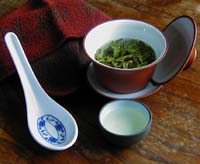 Each week, I offer a tea class to the students of the Puget Sound Community School. Now in its fourth year, I’ve had to push myself every week to learn more about tea so that I had something to teach. Last week I put them to the test: they were to taste the same set of Dragonwell teas that I tasted and wrote about here. (Even though some students are new to the class, those who’ve been at it for four years ought to be able to pick out a good tea…)
Each week, I offer a tea class to the students of the Puget Sound Community School. Now in its fourth year, I’ve had to push myself every week to learn more about tea so that I had something to teach. Last week I put them to the test: they were to taste the same set of Dragonwell teas that I tasted and wrote about here. (Even though some students are new to the class, those who’ve been at it for four years ought to be able to pick out a good tea…)
After reading them a couple of descriptions of what Dragonwell is known for and how it is processed, it was time for the tasting. I had labeled the teas with a letter, had the proper amount measured out, brewed them to the same specifications and gave each student a scoring sheet based on a tea evaluation method that I first read about in Tea: Aromas and Flavors Around the World by Lydia Gautier.
They could give up to two points for dry leaf appearance, one point for infusion (wet leaf), two points for scent of the infusion, a point for the liquor color, and up to 4 points for scent and flavor of liquor.
There were five students in the class that day, and each dutifully inspected the dry leaves, sniffed and observed and prodded the infusion, compared liquors before slurping from their tasting cups…all the while taking notes and awarding points.
When everyone was satisfied, we tallied the points. One tea stood out with nearly 25% more total points than the second-place sample. All of the students graded it their highest, tied for highest with another tea, or second place in their rankings. The tea that won? The same one my partner and I had picked as the best, and the one that was clearly the most expensive of all of the samples, at almost $22 per ounce.
They have learned well. I’m very proud.







